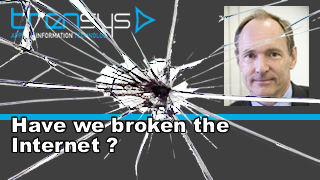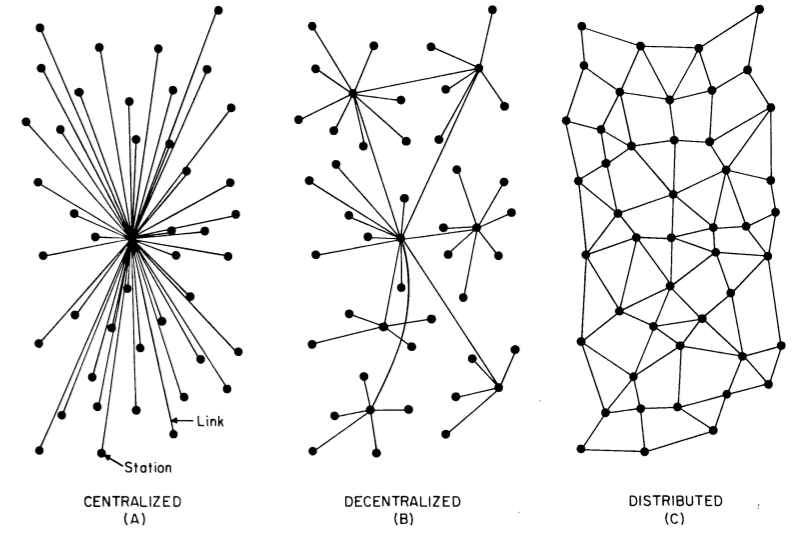Have we broken the internet?

The internet was originally designed to create a communications system that could survive even after large portions of it are destroyed. Have we inadvertently broken that design? The changes we have been making to the internet are they for the better or worse?
History of the internet
The internet is a global computer network providing a variety of information and communications facilities , consisting of interconnected networks using standardised communication protocols.
The key design criteria of the internet is that it should be a communications network that could survive a nuclear war. This was to be achieved by distributing the communications systems across many nodes (locations). If the communications systems is distributed and not centralised , you avoid a central point of attack which will disable the entire communications system.
In 1964 ,an engineer called Paul Baran created a memorandum outlining the introduction to distributed communications networks. In this memorandum he outlines the concepts and design requirements which will eventually become the foundation of the internet in the form of packet switched networking.
Introduction to distributed communications network (by Paul Baran of RAND)
The Centralisation problem
The actual objective of a survivable network is to enable continued communication, even after severe damage. This means that the actual applications ( Computer applications, human voice communications , and data storage and retrieval services )of the network must also be distributed.

Centralising the applications across a distributed network is counter-intuitive and breaks the original design objective.
The internet is a collection of smaller networks, and every network has some form of application, such as file transfer, email services and terminal access to remote computers.
You could say that each network provides some form of service to the other network. Each network was a provider as well a consumer of each others services.
This created a distributed application resource, transported on a distributed network.
The modern way to use these applications is to centralise into what we nonchalantly call “clouds” despite the connotations. A few big providers have emerged (Amazon, Google, Rackspace to name a few) which provide these centralised services across a distributed network.
These providers endeavour to increase survivability by increasing the number of nodes they have and the number of connections, but this can only go so far and remain economical.
We now have an imbalance. We have created a disproportionate number of consumers rather than providers. If every organisation/network becomes a consumer rather than a provider we are destroying the distributed model.
Where node to node (or peer to peer) communications does occur, just as the internet was designed for, it is often feared and needs to be managed and centralised.
The reason for this is because one of the most popular forms of distributed communication applications is peer to peer file sharing. Peer to Peer communication is feared because it has been used to violate copyright and distribute offensive and illegal material.
Therefore the trend is that peer to peer needs to be actively managed. To enable that management it needs to be discouraged or centralised once again.
The Security Problem
 The internet has become the key communication platform of every form. We are free to communicate and share ideas and educate each other across the world. All across this fantastic resilient network.
The internet has become the key communication platform of every form. We are free to communicate and share ideas and educate each other across the world. All across this fantastic resilient network.
This ability also enables criminals and nefarious types to also communicate. Therefore this also has to be managed and observed to reduce the risk of crime.
This introduces the need for security forces and law enforcement to be omnipresent across the internet. Therefore this requires the packets flowing across the internet to be corralled, inspected, filtered and even modified.
To perform these activities also requires some form of centralisation where inspection points can be created. This adds to our centralisation problem and further degrades the survivability of the internet.
BBC news, How vulnerable is the internet?
The Commercial Problem
 E-commerce would not be possible without the creation of the internet. There are a number of new industries created just to exploit these opportunities. What we communicate and also who we communicate with and what material we watch and consume tells a lot about us as a person.
E-commerce would not be possible without the creation of the internet. There are a number of new industries created just to exploit these opportunities. What we communicate and also who we communicate with and what material we watch and consume tells a lot about us as a person.
This information is captured and tied to our personal information to create targeted adverts and to create highly accurate data about our behaviour.
This activity also requires solutions very similar to our security problem. To observe our behaviour and to monetise our actions requires interception points where our data packets can be recorded and even modified according to our demographic or personal tastes.
To compound this problem a new risk to the survivable network is the erosion of network neutrality. Network neutrality is the principle that any of the interconnected networks should be treated equally, not discriminating or charging differentially by user, content, site, platform, application, type of attached equipment, and modes of communication.
Without network neutrality the internet could break up into a tiered service model. Either as the service provider and ultimately the consumer could end up paying more for the type of traffic such as video or peer to peer traffic.
Ultimately the flow of traffic across this resilient network will have artificial commercial restraints drastically changing how we use the internet.
Contextual Advertising Software
What is Net Neutrality and why is it important?
So what, How does that affect me ?
We depend on the internet to pay our bills, do business, entertain ourselves and communicate with our loved ones. As our dependency increases, the reliability of the internet is decreasing.
Windows Azure service down in Europe
Network upgrade failure takes out Amazon
At some point your key services will go down. This is the point to remember. Hopefully you have will now have some insight into some of the reasons why this will happen.
We are designing the internet to fail.
Despite the innovations in High availability systems and Global Load Balancers and ultra high speed fibre connections and site recovery and replication systems, we will continue to see headline outages.
What can I do about it ?
There are only a few things you can do about it. It takes a collective mindset to fix these problems, after all the internet is a collection of networks owned and run by separate organisations.
Here are some simple steps to reduce your exposure to risk
- Before centralising your key services into the cloud, think , What will you do when it goes down?, What will you do when you have to pay an “access fee” or move ISP to access your key cloud service?
- Are you able to manage a service amongst your peers or within your organisation? Are you able to be a service provider as well as a consumer.
Centralised or cloud computing is an important innovation in modern computing. It is a very economical way to utilise large infrastructure without the need for large amounts of investments on the part of the consumer. Only very large organisations have the money and resource to create a computing platform as large as Amazon for example.
However this convenience comes at a cost. That cost is that we are creating large pools of applications which have a low potential for distribution (If you have read this far, then you should know that low distribution is bad). The only way to reduce the exposure to risk, is to augment these applications with distributed peer to peer applications.
Running your own services has been written off as expensive, “don’t worry about it, just put it in the cloud“.
I say it depends !
The same technology which is in use in the cloud, is available to everybody. It is possible to use this cloud technology for yourself. Before you throw your hands up in the air and cry how expensive it is, or you don’t have the resource, at least look at into it.
Hybrid Cloud: Driving the Shift from IT Control to IT Coordination
Research:-2014-Private-Cloud-Survey.html
Gartner Special Report Examines the Outlook for Hybrid Cloud
Summary
Have we broken the internet?. No the internet is not broken. However the design criteria of the internet has changed drastically from it’s original inception.The point of this article is to highlight the changes that are occurring, and to enable you to use the internet with eyes wide open.